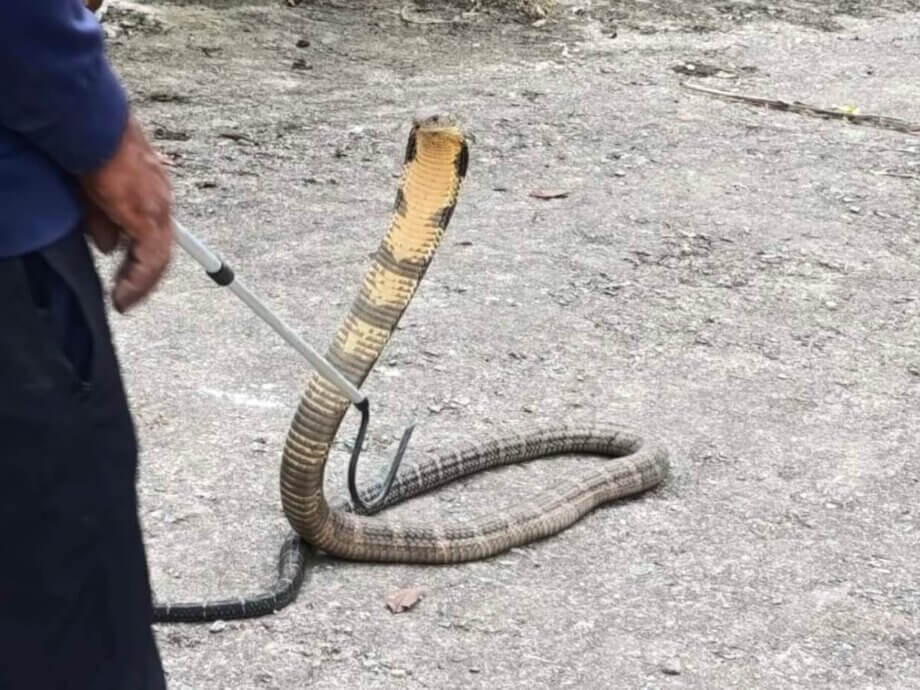Venomous Snakes Move Into Nepal’s Hills and Mountains
In a striking development, at least ten highly venomous snakes—nine King Cobras and one Monocled Cobra—have been rescued from various locations in the Kathmandu Valley over the past month and a half. Traditionally, these species are found in the hot, humid lowlands of Nepal’s Tarai region, but recent sightings and rescues in hilly and even mountainous areas signal a dramatic shift in their habitat.
Officials from Dakshinkali Municipality confirmed that the King Cobras were rescued from residential areas such as Gopaleshwor, Bhanjyang, Sokhol, and Fulchowk. The snakes were found in houses and compounds, then safely released into nearby forests. Locals have also discovered King Cobra eggs and nests in surrounding jungles, suggesting that these snakes are not just passing through—they are adapting and settling in these new, higher-altitude environments.
Why Are Snakes Moving to Higher Altitudes?
Experts point to climate change as the primary driver behind this phenomenon. Nepal is among the countries most vulnerable to the climate crisis, having experienced a rapid rise in extreme weather events over the past decade and a half. Scientific evidence shows that maximum temperatures in Nepal are rising faster than minimum temperatures, with hilly and mountainous districts witnessing a particularly rapid increase—up to 0.05°C per year, outpacing the lowland Terai region.
This warming trend is creating new, suitable habitats for species that were once restricted to tropical lowlands. As a result, snakes like the King Cobra (Ophiophagus hannah) and Monocled Cobra (Naja kaouthia), which typically thrive in dense forests, swamps, and paddy fields, are now able to survive and even breed at higher elevations. The presence of snake nests and eggs in these regions is a clear sign of this adaptation.
Community Safety and Public Health Concerns
The arrival of venomous snakes in new areas has sparked fear among local residents. Rescue operations have become more frequent, with snakes being found in courtyards, homes, and even near schools. Subodh Acharya, a snake rescue trainer from the Mithila Wildlife Trust, notes that some snakes may have initially arrived with transported logs or hay, but have since established permanent habitats in the hills and mountains.
Snakebites are a longstanding public health issue in Nepal, particularly in the Terai, where around 2,700 people—mostly women and children—die from snakebites each year. However, cases are vastly underreported, and the true toll is likely higher. The migration of venomous snakes to higher altitudes now threatens to expand this public health crisis to new regions, where communities may be less prepared to respond.
Challenges in Snakebite Treatment
Most deaths from snakebites occur before victims reach a hospital, often due to a lack of awareness, poor infrastructure, and reliance on traditional healers rather than medical professionals. Rural health facilities frequently face shortages of doctors, anti-snake venom, ventilator support, and dialysis equipment. Vulnerable groups include women collecting fodder, farmers, children playing outdoors, and people living in thatched-roof houses, which attract snakes searching for food.
To address the growing threat, Nepal’s Ministry of Health and Population has expanded snakebite treatment centers to about a dozen locations in hilly regions and increased stocks of anti-snake venom. Nepal imports quadrivalent antivenom from India, effective against four common Indian snake species, though it does not treat bites from pit vipers, whose presence and associated deaths are also rising in the hills.
Expert Warnings and the Role of Climate Change
Scientists and herpetologists warn that the movement of venomous snakes into colder, higher-altitude areas is not a random occurrence. Instead, it is a clear warning sign of the far-reaching impacts of global warming. As temperatures rise, species that once could not survive in the mountains are now able to adapt, breed, and pose new risks to both biodiversity and human safety.
Subodh Acharya, who has led many of the recent rescue operations, emphasizes the need for caution:
“People should be cautious while they are in forests, as rescued venomous snakes have been released there.”
Dr. Sanjib Kumar Sharma, a snakebite expert with the World Health Organization, highlights the importance of rapid medical response:
“People should be encouraged to rush victims to health facilities immediately following a snakebite, as 80 percent of deaths from snakebites occur before reaching hospitals.”
Raising Awareness and Preventing Snakebites
Experts recommend several measures to reduce the risk of snakebites:
- Keep homes and surroundings clean to deter snakes seeking food.
- Prevent children from playing in bushes or tall grass.
- Avoid walking outside at night; if necessary, use a torchlight.
- Encourage immediate medical attention after a snakebite, rather than consulting shamans or traditional healers.
Public health campaigns and training for local health workers are seen as crucial steps toward meeting Nepal’s goal of reducing deaths and disabilities from snakebite envenomation by 50% by 2030, in line with the World Health Organization’s ‘Snakebite Roadmap.’
In Summary
- Venomous snakes, including King Cobras and Monocled Cobras, are now being found and rescued in Nepal’s hilly and mountainous regions, far from their traditional lowland habitats.
- Climate change and rising temperatures are enabling these snakes to adapt to higher altitudes, posing new risks to communities and biodiversity.
- Snakebite deaths remain a major public health issue in Nepal, with rural areas especially vulnerable due to limited healthcare infrastructure and awareness.
- The government is expanding treatment centers and increasing antivenom stocks, but challenges remain, especially for bites from species not covered by available antivenoms.
- Experts stress the need for awareness campaigns, rapid medical response, and improved health infrastructure to address the growing threat of snakebites in new regions.












